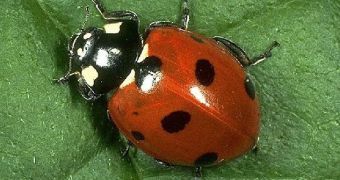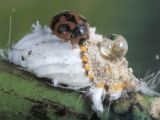We usually detest insects, but this one is amongst our favorites. Ladybirds are beautiful, but for reputed gardeners they are also very useful. Why? Because their food is made almost entirely of plant lice, small soft bodied insects that invade garden plants and crops. Ladybirds eat plant lice both as adult and larva. A sole ladybird eats thousands of plant lice during its lifetime, but also other damaging insects. Some ladybirds also eat fungi attacking the plants.
At the end of the 19th century, Iceria puchasi, a species of Australian plant lice, ruined the citrus fruits in California. The pest bred so quickly that it threatened to destroy all the citrus plantations in the area. An entomologist traveled to Australia to look for its enemy. This was a ladybird: Rodolia cardinalis. 500 individuals were brought to California and in about one year the lice were almost gone.
Most ladybirds do not bypass 12 mm in length, no matter if round or oval-shaped. The delicate rear flight wings are protected by tough shiny elytra wings, wearing the specific ladybird pattern. Of the about 5,000 species of ladybirds, not all have red elytra with black dots. Some can be yellow or orange with black dots, others are black with red dots. There are also dotless ladybirds and some are stripped or with small squares like a chess table.
Most ladybirds do not live more than one year. The adults hibernate in sheltered, dry places or under leaves in warmer places. When the wather is getting warm they awake and start flying searching for lice filled plants. After mating, the females lay a cluster of minute yellow eggs on the lower side of the leaves, close to a good lice reserve. The hatching larvae have three pairs of feet, eat plant lice continuously and grow between molts. After molting several times, the larva attaches to a plant and produces a pupa wrapping. From the pupa an adult gets out; at the beginning it is colorless but the pattern appears in just one day.
Ladybirds are avoided by the insect eaters as when threatened, they expel from the articulations a yellow liquid (children who touched a ladybird know this), foul scented and with a horrible taste. After experiencing this, birds or spiders will never approach a ladybird again. And the vivid colors have exactly this role: to remind of the nasty bite.
Some ladybirds proved harmful when introduced in foreign habitats. The Asian ladybird (Harmonia axyridis) co-exists peacefully with other ladybirds in its native northeastern Asia. Because it is a plant lice exterminator, it was introduced in Europe and North America. But here, it competes for food with the local species of ladybirds (and wins). When there's no plant lice left, this species starts eating local ladybirds and other insects useful for the agriculture. Moreover, it also attacks ripe fruits and in autumn it invades houses to escape cold weather.
Some very few ladybird species are vegetarian and can attack crops but most of them are these natural contamination-free pest slayers.

 14 DAY TRIAL //
14 DAY TRIAL // 
